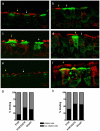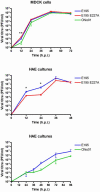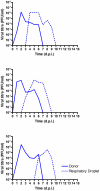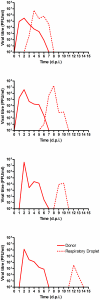A single amino acid in the HA of pH1N1 2009 influenza virus affects cell tropism in human airway epithelium, but not transmission in ferrets
- PMID: 21998692
- PMCID: PMC3187803
- DOI: 10.1371/journal.pone.0025755
A single amino acid in the HA of pH1N1 2009 influenza virus affects cell tropism in human airway epithelium, but not transmission in ferrets
Abstract
The first pandemic of the 21(st) century, pandemic H1N1 2009 (pH1N1 2009), emerged from a swine-origin source. Although human infections with swine-origin influenza have been reported previously, none went on to cause a pandemic or indeed any sustained human transmission. In previous pandemics, specific residues in the receptor binding site of the haemagglutinin (HA) protein of influenza have been associated with the ability of the virus to transmit between humans. In the present study we investigated the effect of residue 227 in HA on cell tropism and transmission of pH1N1 2009. In pH1N1 2009 and recent seasonal H1N1 viruses this residue is glutamic acid, whereas in swine influenza it is alanine. Using human airway epithelium, we show a differential cell tropism of pH1N1 2009 compared to pH1N1 2009 E227A and swine influenza suggesting this residue may alter the sialic acid conformer binding preference of the HA. Furthermore, both pH1N1 2009 E227A and swine influenza multi-cycle viral growth was found to be attenuated in comparison to pH1N1 2009 in human airway epithelium. However this altered tropism and viral growth in human airway epithelium did not abrogate respiratory droplet transmission of pH1N1 2009 E227A in ferrets. Thus, acquisition of E at residue 227 was not solely responsible for the ability of pH1N1 2009 to transmit between humans.
Conflict of interest statement
Figures





Similar articles
-
Hemagglutinin-neuraminidase balance confers respiratory-droplet transmissibility of the pandemic H1N1 influenza virus in ferrets.Proc Natl Acad Sci U S A. 2011 Aug 23;108(34):14264-9. doi: 10.1073/pnas.1111000108. Epub 2011 Aug 8. Proc Natl Acad Sci U S A. 2011. PMID: 21825167 Free PMC article.
-
Experimental adaptation of an influenza H5 HA confers respiratory droplet transmission to a reassortant H5 HA/H1N1 virus in ferrets.Nature. 2012 May 2;486(7403):420-8. doi: 10.1038/nature10831. Nature. 2012. PMID: 22722205 Free PMC article.
-
Influenza Virus with Increased pH of Hemagglutinin Activation Has Improved Replication in Cell Culture but at the Cost of Infectivity in Human Airway Epithelium.J Virol. 2019 Aug 13;93(17):e00058-19. doi: 10.1128/JVI.00058-19. Print 2019 Sep 1. J Virol. 2019. PMID: 31189708 Free PMC article.
-
The soft palate is an important site of adaptation for transmissible influenza viruses.Nature. 2015 Oct 1;526(7571):122-5. doi: 10.1038/nature15379. Epub 2015 Sep 23. Nature. 2015. PMID: 26416728 Free PMC article.
-
Pandemic Swine H1N1 Influenza Viruses with Almost Undetectable Neuraminidase Activity Are Not Transmitted via Aerosols in Ferrets and Are Inhibited by Human Mucus but Not Swine Mucus.J Virol. 2015 Jun;89(11):5935-48. doi: 10.1128/JVI.02537-14. Epub 2015 Mar 25. J Virol. 2015. PMID: 25810540 Free PMC article.
Cited by
-
Accumulation of human-adapting mutations during circulation of A(H1N1)pdm09 influenza virus in humans in the United Kingdom.J Virol. 2014 Nov;88(22):13269-83. doi: 10.1128/JVI.01636-14. Epub 2014 Sep 10. J Virol. 2014. PMID: 25210166 Free PMC article.
-
Analysis of the Contrasting Pathogenicities Induced by the D222G Mutation in 1918 and 2009 Pandemic Influenza A Viruses.J Chem Theory Comput. 2015 May 12;11(5):2307-14. doi: 10.1021/ct5010565. J Chem Theory Comput. 2015. PMID: 26321885 Free PMC article.
-
Investigation of influenza virus polymerase activity in pig cells.J Virol. 2013 Jan;87(1):384-94. doi: 10.1128/JVI.01633-12. Epub 2012 Oct 17. J Virol. 2013. PMID: 23077313 Free PMC article.
-
Characterising viable virus from air exhaled by H1N1 influenza-infected ferrets reveals the importance of haemagglutinin stability for airborne infectivity.PLoS Pathog. 2020 Feb 25;16(2):e1008362. doi: 10.1371/journal.ppat.1008362. eCollection 2020 Feb. PLoS Pathog. 2020. PMID: 32097448 Free PMC article.
-
Viral quasispecies evolution.Microbiol Mol Biol Rev. 2012 Jun;76(2):159-216. doi: 10.1128/MMBR.05023-11. Microbiol Mol Biol Rev. 2012. PMID: 22688811 Free PMC article. Review.
References
-
- Swine influenza A (H1N1) infection in two children--Southern California, March-April 2009. MMWR Morbidity and mortality weekly report. 2009;58:400–402. - PubMed
-
- WHO Pandemic (H1N1) 2009 - update. 2010;112
-
- Smith GJ, Vijaykrishna D, Bahl J, Lycett SJ, Worobey M, et al. Origins and evolutionary genomics of the 2009 swine-origin H1N1 influenza A epidemic. Nature. 2009;459:1122–1125. - PubMed

